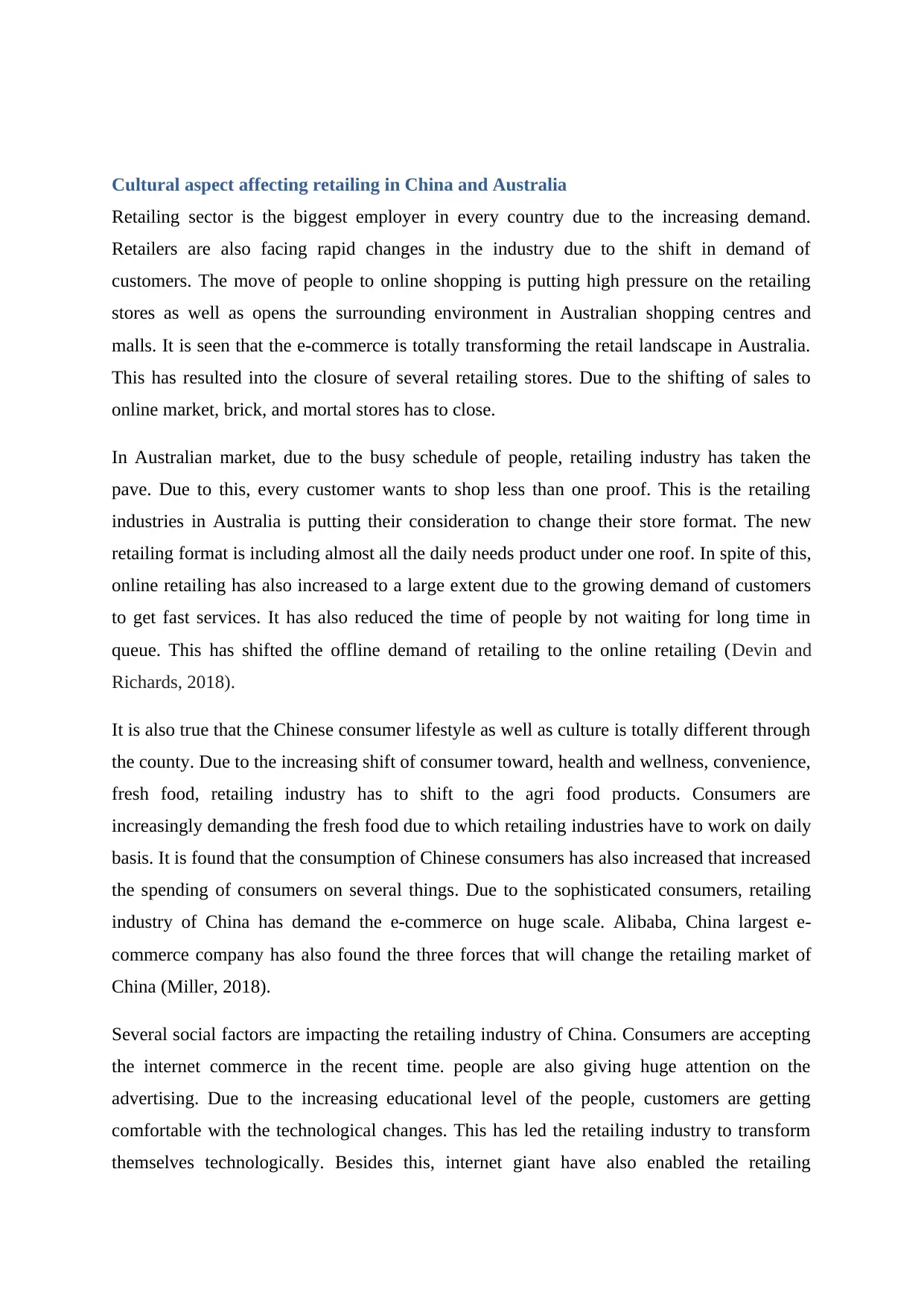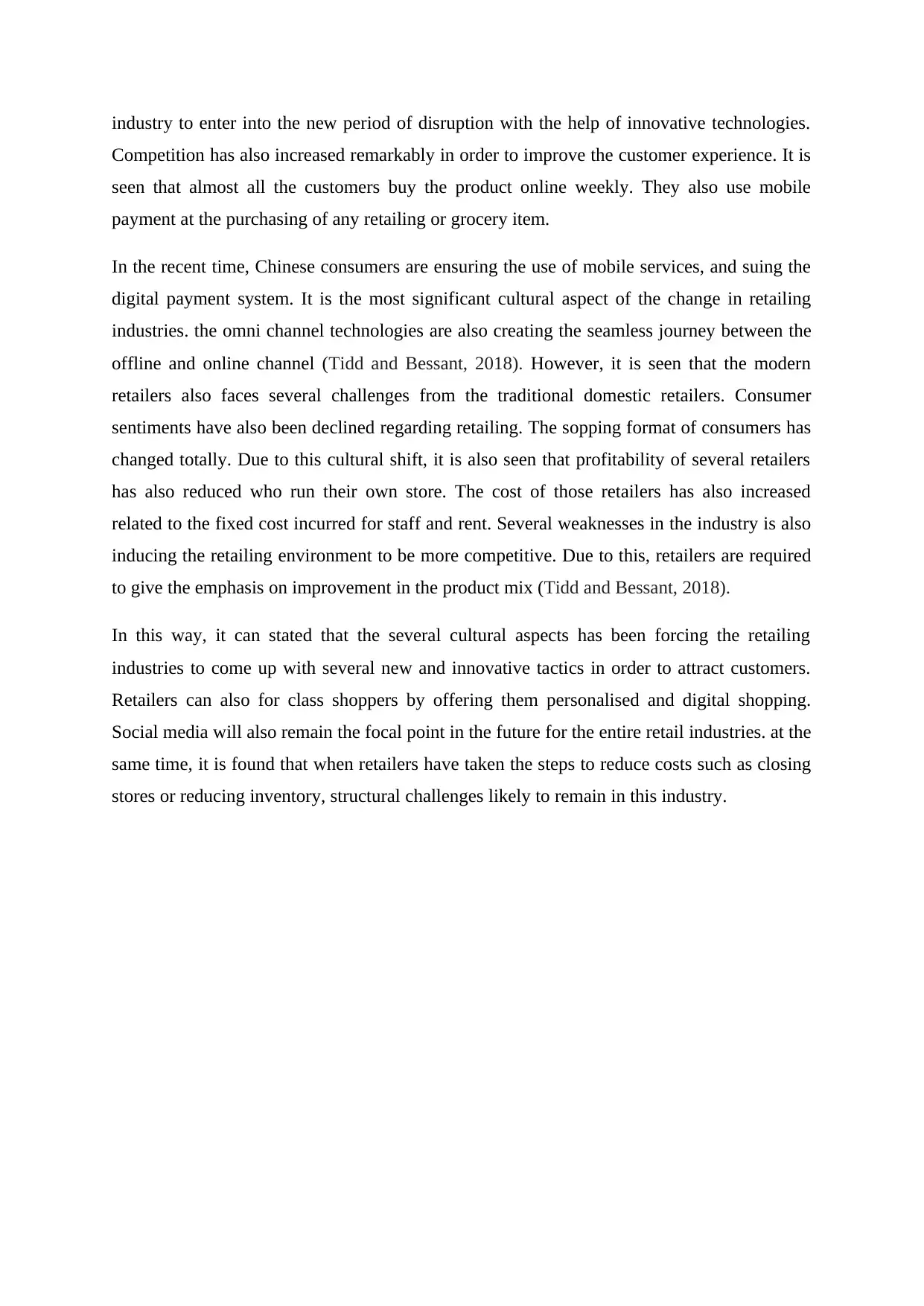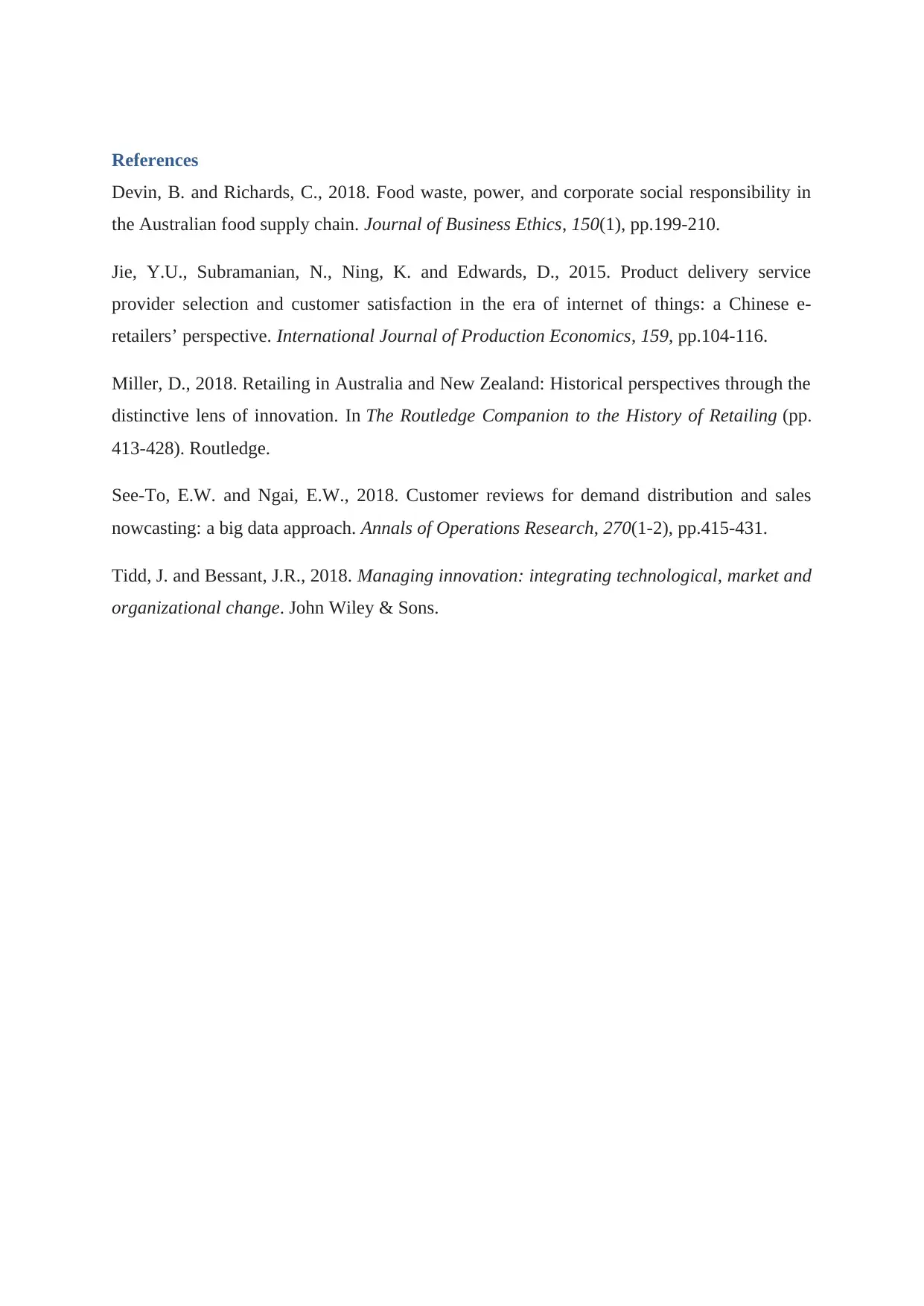Comparative Analysis of Retail Systems: Australia and China
VerifiedAdded on 2022/11/01
|4
|983
|348
Report
AI Summary
This report provides a comparative analysis of the retail industries in Australia and China, focusing on the impact of cultural differences and the rise of e-commerce. It explores the shifting consumer behaviors, including the increasing demand for online shopping and the adoption of mobile payment systems in China. The report examines how these trends are reshaping retail formats, from traditional brick-and-mortar stores to omnichannel strategies. It highlights the challenges faced by retailers, such as increased competition and changing consumer sentiments, and emphasizes the need for innovation and adaptation to remain competitive. Key aspects discussed include the influence of social factors, the importance of fresh food in China, and the implications of these changes for retail management and strategy. References are provided to support the analysis.

qwertyuiopasdfghjklzxcvbnmqw
ertyuiopasdfghjklzxcvbnmqwert
yuiopasdfghjklzxcvbnmqwertyui
opasdfghjklzxcvbnmqwertyuiop
asdfghjklzxcvbnmqwertyuiopasd
fghjklzxcvbnmqwertyuiopasdfgh
jklzxcvbnmqwertyuiopasdfghjkl
zxcvbnmqwertyuiopasdfghjklzxc
vbnmqwertyuiopasdfghjklzxcvb
nmqwertyuiopasdfghjklzxcvbnm
qwertyuiopasdfghjklzxcvbnmqw
ertyuiopasdfghjklzxcvbnmqwert
yuiopasdfghjklzxcvbnmqwertyui
opasdfghjklzxcvbnmqwertyuiop
asdfghjklzxcvbnmqwertyuiopasd
fghjklzxcvbnmqwertyuiopasdfgh
jklzxcvbnmrtyuiopasdfghjklzxcv
Retail management
ertyuiopasdfghjklzxcvbnmqwert
yuiopasdfghjklzxcvbnmqwertyui
opasdfghjklzxcvbnmqwertyuiop
asdfghjklzxcvbnmqwertyuiopasd
fghjklzxcvbnmqwertyuiopasdfgh
jklzxcvbnmqwertyuiopasdfghjkl
zxcvbnmqwertyuiopasdfghjklzxc
vbnmqwertyuiopasdfghjklzxcvb
nmqwertyuiopasdfghjklzxcvbnm
qwertyuiopasdfghjklzxcvbnmqw
ertyuiopasdfghjklzxcvbnmqwert
yuiopasdfghjklzxcvbnmqwertyui
opasdfghjklzxcvbnmqwertyuiop
asdfghjklzxcvbnmqwertyuiopasd
fghjklzxcvbnmqwertyuiopasdfgh
jklzxcvbnmrtyuiopasdfghjklzxcv
Retail management
Paraphrase This Document
Need a fresh take? Get an instant paraphrase of this document with our AI Paraphraser

Cultural aspect affecting retailing in China and Australia
Retailing sector is the biggest employer in every country due to the increasing demand.
Retailers are also facing rapid changes in the industry due to the shift in demand of
customers. The move of people to online shopping is putting high pressure on the retailing
stores as well as opens the surrounding environment in Australian shopping centres and
malls. It is seen that the e-commerce is totally transforming the retail landscape in Australia.
This has resulted into the closure of several retailing stores. Due to the shifting of sales to
online market, brick, and mortal stores has to close.
In Australian market, due to the busy schedule of people, retailing industry has taken the
pave. Due to this, every customer wants to shop less than one proof. This is the retailing
industries in Australia is putting their consideration to change their store format. The new
retailing format is including almost all the daily needs product under one roof. In spite of this,
online retailing has also increased to a large extent due to the growing demand of customers
to get fast services. It has also reduced the time of people by not waiting for long time in
queue. This has shifted the offline demand of retailing to the online retailing (Devin and
Richards, 2018).
It is also true that the Chinese consumer lifestyle as well as culture is totally different through
the county. Due to the increasing shift of consumer toward, health and wellness, convenience,
fresh food, retailing industry has to shift to the agri food products. Consumers are
increasingly demanding the fresh food due to which retailing industries have to work on daily
basis. It is found that the consumption of Chinese consumers has also increased that increased
the spending of consumers on several things. Due to the sophisticated consumers, retailing
industry of China has demand the e-commerce on huge scale. Alibaba, China largest e-
commerce company has also found the three forces that will change the retailing market of
China (Miller, 2018).
Several social factors are impacting the retailing industry of China. Consumers are accepting
the internet commerce in the recent time. people are also giving huge attention on the
advertising. Due to the increasing educational level of the people, customers are getting
comfortable with the technological changes. This has led the retailing industry to transform
themselves technologically. Besides this, internet giant have also enabled the retailing
Retailing sector is the biggest employer in every country due to the increasing demand.
Retailers are also facing rapid changes in the industry due to the shift in demand of
customers. The move of people to online shopping is putting high pressure on the retailing
stores as well as opens the surrounding environment in Australian shopping centres and
malls. It is seen that the e-commerce is totally transforming the retail landscape in Australia.
This has resulted into the closure of several retailing stores. Due to the shifting of sales to
online market, brick, and mortal stores has to close.
In Australian market, due to the busy schedule of people, retailing industry has taken the
pave. Due to this, every customer wants to shop less than one proof. This is the retailing
industries in Australia is putting their consideration to change their store format. The new
retailing format is including almost all the daily needs product under one roof. In spite of this,
online retailing has also increased to a large extent due to the growing demand of customers
to get fast services. It has also reduced the time of people by not waiting for long time in
queue. This has shifted the offline demand of retailing to the online retailing (Devin and
Richards, 2018).
It is also true that the Chinese consumer lifestyle as well as culture is totally different through
the county. Due to the increasing shift of consumer toward, health and wellness, convenience,
fresh food, retailing industry has to shift to the agri food products. Consumers are
increasingly demanding the fresh food due to which retailing industries have to work on daily
basis. It is found that the consumption of Chinese consumers has also increased that increased
the spending of consumers on several things. Due to the sophisticated consumers, retailing
industry of China has demand the e-commerce on huge scale. Alibaba, China largest e-
commerce company has also found the three forces that will change the retailing market of
China (Miller, 2018).
Several social factors are impacting the retailing industry of China. Consumers are accepting
the internet commerce in the recent time. people are also giving huge attention on the
advertising. Due to the increasing educational level of the people, customers are getting
comfortable with the technological changes. This has led the retailing industry to transform
themselves technologically. Besides this, internet giant have also enabled the retailing

industry to enter into the new period of disruption with the help of innovative technologies.
Competition has also increased remarkably in order to improve the customer experience. It is
seen that almost all the customers buy the product online weekly. They also use mobile
payment at the purchasing of any retailing or grocery item.
In the recent time, Chinese consumers are ensuring the use of mobile services, and suing the
digital payment system. It is the most significant cultural aspect of the change in retailing
industries. the omni channel technologies are also creating the seamless journey between the
offline and online channel (Tidd and Bessant, 2018). However, it is seen that the modern
retailers also faces several challenges from the traditional domestic retailers. Consumer
sentiments have also been declined regarding retailing. The sopping format of consumers has
changed totally. Due to this cultural shift, it is also seen that profitability of several retailers
has also reduced who run their own store. The cost of those retailers has also increased
related to the fixed cost incurred for staff and rent. Several weaknesses in the industry is also
inducing the retailing environment to be more competitive. Due to this, retailers are required
to give the emphasis on improvement in the product mix (Tidd and Bessant, 2018).
In this way, it can stated that the several cultural aspects has been forcing the retailing
industries to come up with several new and innovative tactics in order to attract customers.
Retailers can also for class shoppers by offering them personalised and digital shopping.
Social media will also remain the focal point in the future for the entire retail industries. at the
same time, it is found that when retailers have taken the steps to reduce costs such as closing
stores or reducing inventory, structural challenges likely to remain in this industry.
Competition has also increased remarkably in order to improve the customer experience. It is
seen that almost all the customers buy the product online weekly. They also use mobile
payment at the purchasing of any retailing or grocery item.
In the recent time, Chinese consumers are ensuring the use of mobile services, and suing the
digital payment system. It is the most significant cultural aspect of the change in retailing
industries. the omni channel technologies are also creating the seamless journey between the
offline and online channel (Tidd and Bessant, 2018). However, it is seen that the modern
retailers also faces several challenges from the traditional domestic retailers. Consumer
sentiments have also been declined regarding retailing. The sopping format of consumers has
changed totally. Due to this cultural shift, it is also seen that profitability of several retailers
has also reduced who run their own store. The cost of those retailers has also increased
related to the fixed cost incurred for staff and rent. Several weaknesses in the industry is also
inducing the retailing environment to be more competitive. Due to this, retailers are required
to give the emphasis on improvement in the product mix (Tidd and Bessant, 2018).
In this way, it can stated that the several cultural aspects has been forcing the retailing
industries to come up with several new and innovative tactics in order to attract customers.
Retailers can also for class shoppers by offering them personalised and digital shopping.
Social media will also remain the focal point in the future for the entire retail industries. at the
same time, it is found that when retailers have taken the steps to reduce costs such as closing
stores or reducing inventory, structural challenges likely to remain in this industry.
⊘ This is a preview!⊘
Do you want full access?
Subscribe today to unlock all pages.

Trusted by 1+ million students worldwide

References
Devin, B. and Richards, C., 2018. Food waste, power, and corporate social responsibility in
the Australian food supply chain. Journal of Business Ethics, 150(1), pp.199-210.
Jie, Y.U., Subramanian, N., Ning, K. and Edwards, D., 2015. Product delivery service
provider selection and customer satisfaction in the era of internet of things: a Chinese e-
retailers’ perspective. International Journal of Production Economics, 159, pp.104-116.
Miller, D., 2018. Retailing in Australia and New Zealand: Historical perspectives through the
distinctive lens of innovation. In The Routledge Companion to the History of Retailing (pp.
413-428). Routledge.
See-To, E.W. and Ngai, E.W., 2018. Customer reviews for demand distribution and sales
nowcasting: a big data approach. Annals of Operations Research, 270(1-2), pp.415-431.
Tidd, J. and Bessant, J.R., 2018. Managing innovation: integrating technological, market and
organizational change. John Wiley & Sons.
Devin, B. and Richards, C., 2018. Food waste, power, and corporate social responsibility in
the Australian food supply chain. Journal of Business Ethics, 150(1), pp.199-210.
Jie, Y.U., Subramanian, N., Ning, K. and Edwards, D., 2015. Product delivery service
provider selection and customer satisfaction in the era of internet of things: a Chinese e-
retailers’ perspective. International Journal of Production Economics, 159, pp.104-116.
Miller, D., 2018. Retailing in Australia and New Zealand: Historical perspectives through the
distinctive lens of innovation. In The Routledge Companion to the History of Retailing (pp.
413-428). Routledge.
See-To, E.W. and Ngai, E.W., 2018. Customer reviews for demand distribution and sales
nowcasting: a big data approach. Annals of Operations Research, 270(1-2), pp.415-431.
Tidd, J. and Bessant, J.R., 2018. Managing innovation: integrating technological, market and
organizational change. John Wiley & Sons.
1 out of 4
Related Documents
Your All-in-One AI-Powered Toolkit for Academic Success.
+13062052269
info@desklib.com
Available 24*7 on WhatsApp / Email
![[object Object]](/_next/static/media/star-bottom.7253800d.svg)
Unlock your academic potential
Copyright © 2020–2025 A2Z Services. All Rights Reserved. Developed and managed by ZUCOL.





